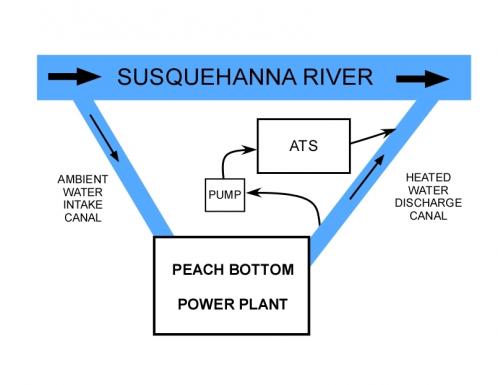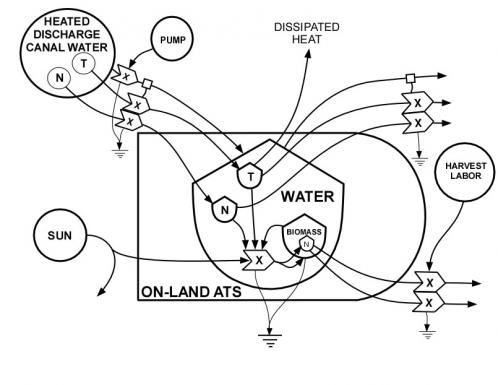Buffalo, New York ATS Project
Pilot scale ATS were constructed and operated on the waterfront of Buffalo, New York at the SUNY Buffalo’s Great Lakes Research Center to provide a test of the technology in the Lake Erie environment. Two raceways, each 12 meters long and 0.3 meters wide, were studied. Although algal growth was reduced by ice during winter months, during the growing season productivity was within the range of values found in other ATS studies. As part of this research effort, preliminary work was also undertaken on a floating system in which algae was grown on screens suspended in the water.
Baltimore Inner Harbor ATS Project
The ATS project on the Baltimore Inner Harbor was undertaken to examine water quality performance in an urban setting. The site was located near Fells Point on a dead-end canal bordered by concrete bulkheads and stone rip-rap. Water quality conditions here are impaired by urban stormwater runoff and overflow sewage discharges. The ATS was the wooden raceway that had previously been used in the Muddy Run Study, which is one foot wide and 300 feet long. Data on algal productivity and nutrient uptake values were similar to other ATS study sites. A special finding of the project was that oxygen produced by the ATS can provide a refuge for aquatic organisms during low oxygen events, which are common in urban settings.
Peach Bottom ATS Project
The ATS project at the Peach Bottom Atomic Power Facility is being conducted in collaboration with the Exelon Energy Corporation. The site is located on the south side of the Susquehanna River in southeastern Pennsylvania. The ATS unit is an aluminum trough that is one foot wide and 300’ long (the same system that had been operated at Exelon’s Muddy Run Hydroelectric facility in 2008-2009). Algae are grown in the experimental ATS with the heated water that had been used for cooling the nuclear reactors. This research is of special interest in the context of possibly extending the growing season of algae in the temperate zone. In particular, research at Peach Bottom will help distinguish between light and temperature as limiting factors to algal growth during the winter.


Jamaica Bay, New York City ATS Project
The algal turf scrubber project in New York City is located at the Rockaway Water Pollution Control Plant in Rockaway, Queens. The project is funded by the New York City Department of Environmental Protection (NYCDEP) and is part of a larger project testing a variety of pilot environmental technologies for the restoration of Jamaica Bay, New York City. Oversight of the project is by C. Streb and P. May of Biohabitats, Inc. a Baltimore, Maryland based environmental firm. The system consists of dual floways each 350’ by 1’ in size. The floways are operated with wastewater from secondary treatment at the Rockaway Water Pollution Control Plant with loading rates of 20 gallons/minute and 40 gallons/minute. The project began in September 2010 and the research is in progress.
Collier Farm Project
The ATS project at the Collier Farm in Caroline County, Maryland on the Eastern Shore was conducted from 2009 to 2011. Support for the project was from the Fish and Wildlife Foundation through a Small Watershed Grant to the Caroline County Soil Conservation District. Algae were grown with water from a large agricultural drainage ditch. The ATS was 6 meters wide and 50 meters long with a 2% slope and was placed on the ground with a landfill liner to retain the water. The overall purpose of the research was to test the performance of the algal production system for water quality improvement of the agricultural drainage water. A more specific objective of the research was to run the pumps that move water to the system with solar power. The intention was to demonstrate how the algal production technology might operate remotely, away from the electrical grid, as would be desirable on farms in rural landscapes.
Report 1 | Report 2 | Report 3 | Tech. Report | Poster
USDA Dairy Wastewater Studies
A research project on the use of ATS for dairy wastewater treatment was conducted from 2003 to 2006 by Walter Mulbry of the USDA Agricultural Research Service. The work was carried out at the experimental dairy farm of the National Agricultural Laboratory, located in Beltsville, Maryland. Four ATS raceways, each 1 meter wide and 30 meters long, were constructed on the ground with the screens placed on landfill liner. Two raceways had a 1% slope and the other two had a 2% slope. Productivity and nutrient uptake data along with economic costs were assessed. Studies also demonstrated the utility of the harvested algal biomass as a fertilizer.
Publication 1 | Publication 2 | Publication 3 | Publication 4 | Publications 5
The Great Wicomico River, Virginia ATS Study
The ATS project on the Great Wicomico River in Northern Virginia was carried out by Walter Adey as part of the larger STATOIL project (termed CHAP or the Chesapeake Algae Project). The site is brackish with salinity of 12-15 ppt. Two elevated raceways were operated from Fall 2009 until Spring 2011. One raceway was 80 feet long with a slope of 2% and the other was 50 feet long with a slope of 1%. A number of different studies were undertaken at this site including algal biodiversity surveys, CO2 and other additions and detailed analyses of biochemistry of the algal biomass from the screens. One special emphasis was study of a three dimensional screen for growing algae. This is a new approach since previously algae have been grown on a standard, two dimensional screen. Results demonstrate significantly higher productivity on the three dimensional screen as compared with the two dimensional screen.
Muddy Run Project
The ATS project at the Muddy Run Hydroelectric Facility was conducted in collaboration with the Exelon Energy Corporation from mid-2008 to late 2009 with support from the Lewis Foundation through the Smithsonian Institution. The site is located on the north side of the Susquehanna River in southeastern Pennsylvania. Two elevated ATS units were operated, each 1 foot wide and 300 feet long. One ATS was constructed of aluminum with a 2% slope and the other was constructed of wood with a 1% slope. Algae were grown in the experimentally ATS from the Muddy Run Reservoir which is part of the pumped storage design of the hydroelectric facility.
University of Arkansas Biofuel Project
Algal biomass can be used to produce liquid biofuels and research among our collaborators has focused on butanol production. Butanol has several advantages over ethanol as a fuel and it has an existing market as a chemical solvent. Research at the University of Arkansas, led by Jamie Hestekin, Christa Hestekin and Robert Beitle, has been underway for several years with funding from the Environmental Protection Agency, the Mack Blackwell Rural Transportation Center and the Norwegian oil company STATOIL along with other sources of support. The focus of the work has been to develop a biorefinery that converts algal biomass into butanol through fermentation. This approach uses a novel fermentation process that centers around several membrane separations. This research group has won an EPA competition for their work on algal biofuels and has produced a sample of algal butanol as part of the New York City ATS Project.